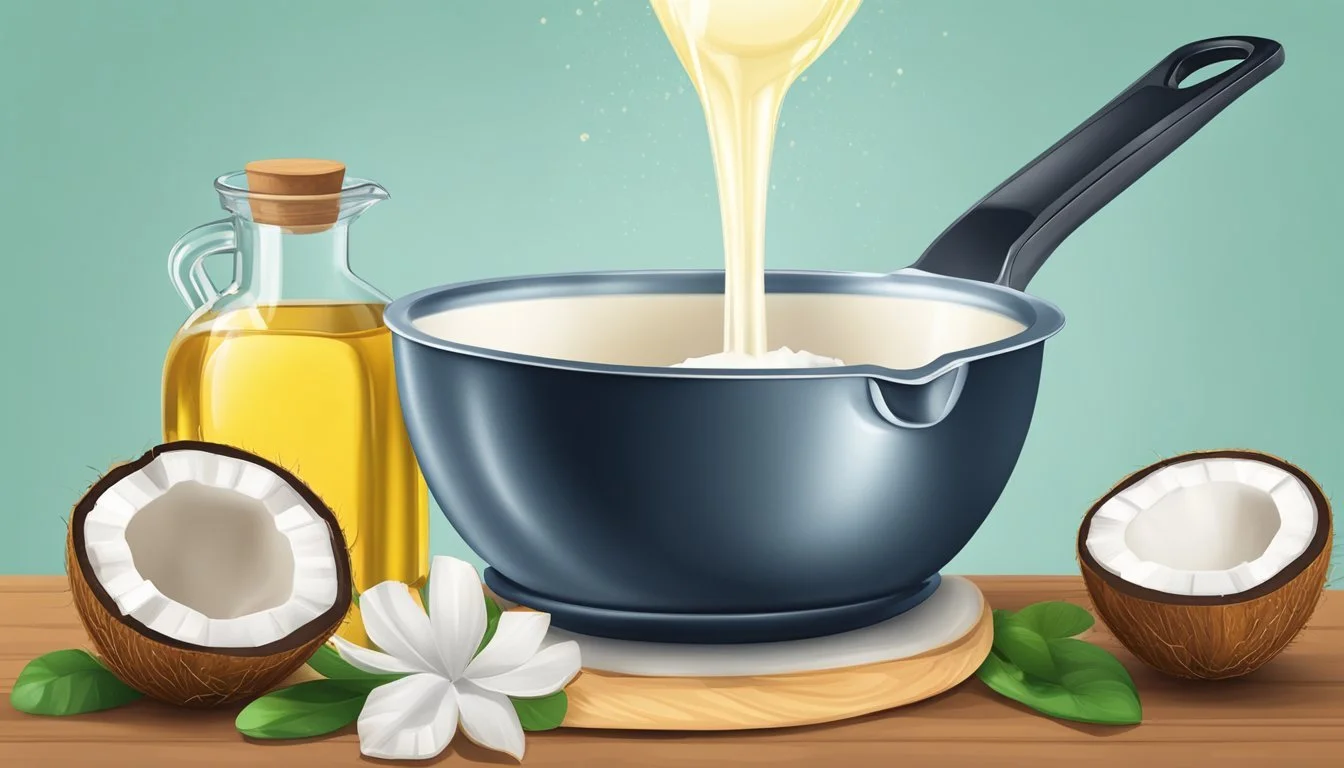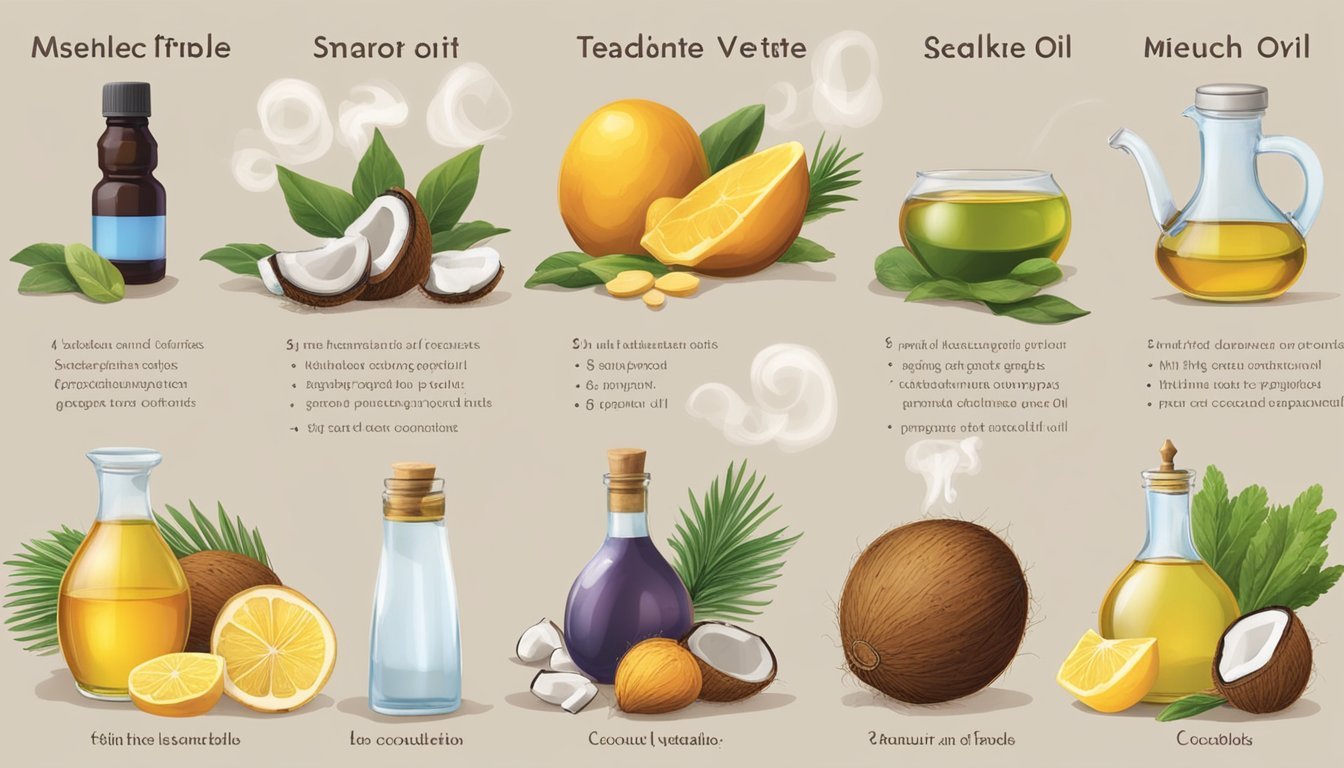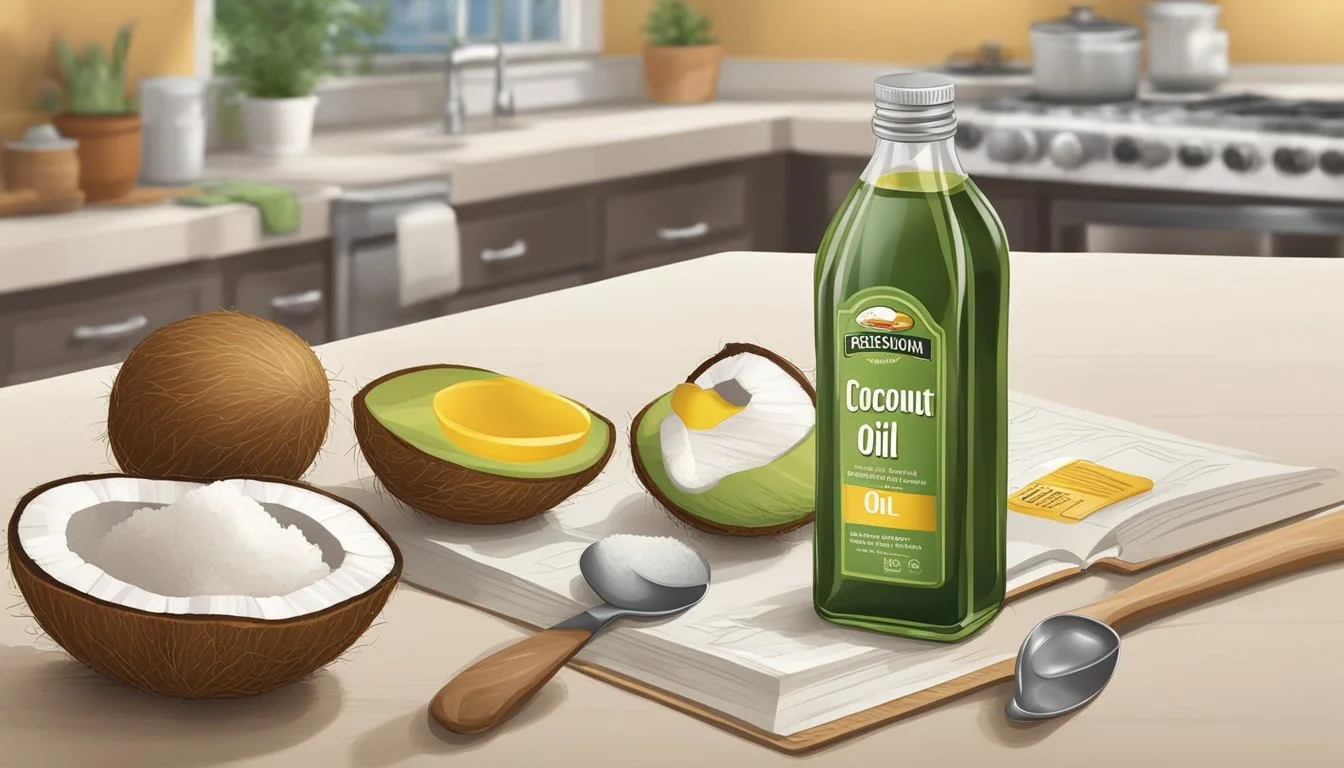How to Substitute Coconut Oil for Vegetable Oil
A Clear Guide
In the culinary world, the versatility of oils plays a significant role in both cooking and baking. Coconut oil has gained popularity as a substitute for traditional vegetable oil, offering a unique flavor profile and different health benefits. It is a plant-based fat that is extracted from the meat of coconuts and can be used in a variety of recipes. When substituting coconut oil for vegetable oil, the process is relatively simple, as it generally requires a one-to-one ratio.
When using coconut oil in place of vegetable oil, it's important to consider the form of the coconut oil. At temperatures below 75 degrees Fahrenheit, coconut oil is solid, and it becomes liquid above that temperature. Therefore, for successful integration into recipes, particularly in baking, coconut oil should be melted to match the consistency of vegetable oil. This ensures that it blends uniformly with other ingredients.
One must note, however, that coconut oil has a distinct taste which can alter the flavor profile of the dish. In cases where the coconut flavor is not desired, one can add a teaspoon of vanilla to the recipe to mask the coconut taste. When stored properly in a cool, dry place, coconut oil's shelf life is quite impressive, making it a convenient oil to keep on hand for various cooking and baking needs.
Understanding Fats and Oils
In order to substitute coconut oil for vegetable oil effectively, it is essential to understand their respective compositions and the health implications of each. This section will provide clarity on the types of fats present in coconut oil and vegetable oil, as well as discuss their associated health benefits and considerations.
Composition of Coconut Oil and Vegetable Oil
Coconut oil is primarily composed of medium-chain saturated fatty acids (MCFAs), including a high proportion of lauric acid. This type of saturated fat behaves differently in the body compared to long-chain fatty acids found in many other oils. On the other hand, vegetable oils are typically high in unsaturated fats, including both monounsaturated and polyunsaturated fatty acids like omega-6. The ratio of these fatty acids can vary between different types of vegetable oils.
Coconut Oil:
Saturated fat: Predominantly composed of MCFAs such as lauric acid.
Cholesterol: No cholesterol is present in coconut oil; however, its saturated fat content can influence blood cholesterol levels in the body.
Vegetable Oil:
Unsaturated fats: Generally contains higher levels of monounsaturated and omega-6 polyunsaturated fatty acids.
Cholesterol: Typically free from cholesterol like all plant-based oils.
Health Benefits and Considerations
When considering health benefits, both oils offer antioxidants that help counteract free radicals, reducing inflammation and potentially the risk of heart disease.
Coconut Oil:
Metabolism: MCFAs in coconut oil are metabolized differently, potentially offering a boost to metabolism.
Immune System: The lauric acid in coconut oil is known to have antimicrobial properties, which may support the immune system.
Vegetable Oil:
Healthy Fats: The unsaturated fats may contribute to better heart health when they replace saturated fats in the diet.
Omega-6 Fatty Acids: While essential, an excessive intake of omega-6 fatty acids without balance from omega-3s may contribute to inflammation.
It is important for consumers to consider the specific type of vegetable oil, as different oils have varied compositions of fatty acids. The choice between coconut oil and vegetable oil may also depend on individual health profiles, dietary needs, and cooking methods.
Comparing Smoke Points and Flavor Profiles
When substituting coconut oil for vegetable oil, one must consider the differences in smoke points and the impact on flavor profiles within dishes.
Smoke Point Differences
Coconut Oil:
Refined coconut oil has a smoke point of about 450°F, which is comparably high and suitable for most cooking applications, including sautéing and baking.
Virgin coconut oil typically has a lower smoke point around 350°F, making it better suited for lower-heat cooking or as a finishing oil.
Vegetable Oil:
Generally has a smoke point around 400°F, which is ideal for a variety of cooking methods, including frying and roasting.
Neutral in flavor, vegetable oil does not impact the taste of the final dish significantly, unlike coconut oil.
Taste and Aromas
Coconut Oil:
Virgin coconut oil imparts a distinct sweet coconut flavor and aroma, which can enhance tropical or sweet dishes but may clash with savory flavors.
Refined coconut oil is more neutral, similar to vegetable oil, though it may still carry a subtle hint of coconut.
Vegetable Oil:
Typically offers a neutral flavor, which does not alter the taste profile of dishes.
Can occasionally have a nutty flavor, especially if it is derived from nut-based source oils such as sunflower or olive oil.
Substitution Guidelines
When substituting coconut oil for vegetable oil, it's crucial to understand the proper ratio and how to adapt it to different types of recipes to achieve the best results.
General Ratio for Substitution
The baseline recommendation for replacing vegetable oil with coconut oil is a 1:1 ratio. This means if a recipe requires one cup of vegetable oil, one should use one cup of melted coconut oil as a direct replacement.
Modifications for Baked Goods
In baking recipes, coconut oil should be used in its liquid state to ensure even distribution. Coconut oil becomes liquid above 75 degrees Fahrenheit and should be measured after melting. When substituting for butter, use coconut oil in a solid state, maintaining the same 1:1 ratio.
Adapting for Savory Dishes
For savory dishes such as curries, stir-fries, and marinades, the coconut oil can be used in either solid or liquid form, depending on the cooking temperature. However, for salad dressings or dishes served at room temperature, ensure the coconut oil is in a liquid state to avoid a gritty texture.
Alternative Oils and Substitutes
When substituting coconut oil for vegetable oil, it's crucial to consider the cooking method and flavor profile of the dish. Certain oils may be more suitable for high-heat applications, while others are preferred for their neutral taste or health benefits.
Other Plant-Based Oil Options
Various plant-based oils can serve as substitutes for coconut oil, often on a 1:1 basis. Here are suitable options:
Olive Oil: Best for low-temperature cooking or dressings due to its low smoke point.
Canola Oil: A neutral-tasting oil that's versatile for different cooking applications.
Sunflower Oil: Great for high-heat cooking and maintains a light taste.
Soybean Oil: Widely used oil with a relatively high smoke point.
Corn Oil: Another high smoke point oil, ideal for frying.
Grapeseed Oil: Good for sautéing and stir-frying with its moderate smoke point.
Avocado Oil: Excellent for high-heat cooking and carries additional health benefits.
Almond Oil: Suitable for adding a nutty flavor to dishes.
Safflower Oil: Preferred for its neutral flavor and high smoke point.
Non-Oil Substitutes for Specific Uses
In some recipes, non-oil substitutes can replace coconut oil to reduce fat content or to cater to specific dietary needs.
Applesauce: A common replacement in baking to add moisture without the fat.
Use at a 1:1 ratio or as recipe suggests, keeping in mind it can alter texture and sweetness.
Yogurt: Adds moisture and creaminess to baked goods, enhancing the protein content.
Typically used in a specific ratio to oil, which may vary by recipe.
Practical Tips for Cooking and Baking
When substituting coconut oil for vegetable oil, cooks should consider the state of coconut oil. Below 75 degrees Fahrenheit, coconut oil remains solid. Therefore, one should melt it before mixing into batters to ensure even distribution.
Measurement Equivalence:
The ratio for substitution is 1:1; if a recipe requires one cup of vegetable oil, one should use the same volume of coconut oil.
Melting Coconut Oil:
Coconut oil should be melted gently over low heat or at room temperature if the ambient temperature is warm enough to liquify it without overheating, as excess heat may impact some recipes.
Extra-Virgin Olive Oil:
For savory dishes, if the slight taste of coconut is undesirable, one might opt for extra-virgin olive oil, which also provides a 1:1 substitution ratio.
Ingredient to Substitute Amount of Vegetable Oil Amount of Coconut Oil Coconut Oil 1 cup 1 cup (melted) Extra-Virgin Olive Oil 1 cup 1 cup
In a kitchen cabinet, cooks should store coconut oil in a cool, dry place. When substituting oils in baking, weigh or measure the oils after melting to ensure accuracy, as the volume could change slightly when transitioning from solid to liquid form. Remember to allow the melted coconut oil to cool a bit before adding it to other ingredients, especially when baking goods such as cakes or cookies, to avoid affecting the texture or causing ingredients like eggs to cook prematurely.
Dietary Impact and Considerations
When substituting coconut oil for vegetable oil, it's important to consider the dietary impact such a change could introduce. Coconut oil's fat content and potential influence on cholesterol levels are significant factors, while awareness of risks related to allergies and inflammatory diseases can guide appropriate usage.
Incorporating Oils into a Healthy Diet
Coconut oil is high in saturated fats, which are more heart healthy when balanced within a diverse diet that limits excessive intake of processed foods. It provides a different set of nutritional benefits and considerations in contrast to most vegetable oils, which may contain less saturated fat. The American Heart Association recommends that saturated fats should not exceed 5-6% of total daily calories to maintain healthy cholesterol levels. Using coconut oil in moderation can be part of a balanced diet that aims to manage fat content effectively.
Potential Risks and Allergies
Coconut oil is typically less processed than many conventional vegetable oils, potentially reducing exposure to unwanted chemicals. However, individuals should remain vigilant regarding the risk of allergic reactions, although coconut allergies are less common. The consumption of coconut oil should also be monitored for those with existing inflammatory diseases since high levels of saturated fats can exacerbate certain conditions. No documented evidence links coconut oil with the promotion of pathogens in the diet; nonetheless, it is always prudent to maintain proper food safety practices in the kitchen.
Final Thoughts
When substituting coconut oil for vegetable oils such as canola or sunflower oil, it is important to remember that coconut oil has a unique flavor and might impart a distinct taste to the dish. This should be considered especially in recipes where the neutral taste of vegetable oil is preferable.
Extra virgin coconut oil is a potential substitute, but one should be mindful of its strong aroma and flavor, which can dominate a dish. In baking, coconut oil should be melted if the recipe requires a liquid form since it is typically solid at room temperature.
Regarding health considerations, coconut oil contains saturated fats, which are a concern for some individuals. On the other hand, canola and sunflower oils contain more unsaturated fats, which are considered heart-healthy options.
Here's a simple guide for substitution:
Baking: Use equal amounts and melt coconut oil if necessary.
Cooking: Replace in a 1:1 ratio, but start with a smaller amount if adjusting to the taste.
Flavor: Extra virgin coconut oil is flavorful, impacting the final taste of the dish.
Bear in mind that while coconut oil is versatile, it may not be suitable for every recipe calling for vegetable oils due to its distinct characteristics. The substitution should be done with an understanding of how it affects the overall dish, both in flavor and texture.






